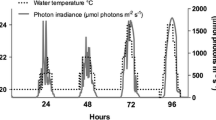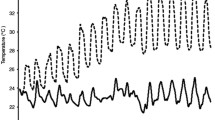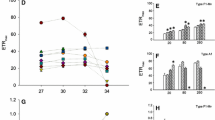Abstract
It is speculated that differences in coral bleaching susceptibility may be influenced by the genotype of in hospite Symbiodinium and their differential responses to bleaching stressors. Photoinhibition of photosystem II (PSII), damage to the D1 (psbA) PSII reaction centre protein and production of reactive oxygen species by in hospite Symbiodinium are likely precursors of coral bleaching. In order to assess whether photorepair rates of in hospite Symbiodinium underlie the bleaching susceptibility of their hosts, photoinhibition (net and gross), photoprotection and photorepair rates were assessed in a bleaching-‘tolerant’ coral (P. astreoides) and a bleaching-‘sensitive’ coral (M. faveolata) using non-invasive fluorometric techniques and by blocking de novo synthesis of psbA. Previous studies using such techniques have demonstrated that in vitro Symbiodinium types ‘sensitive’ to bleaching stressors had reduced rates of photorepair relative to ‘tolerant’ Symbiodinum types. Our measurements demonstrated that Symbiodinium in the more bleaching tolerant P. astreoides had higher photorepair rates than Symbiodinium in M. faveolata. Higher repair rates in P. astreoides resulted in lower net photoinhibition relative to M. faveolata, where both corals exhibited similar susceptibility to photodamage (gross photoinhibition). Photoprotective mechanisms were observed in both corals; M. faveolata exhibited higher antennae-bed quenching than P. astreoides at low-light intensities, but at and above light-saturating intensities, which are different for each coral species, P. astreoides displayed more efficient non-photochemical quenching (Stern–Volmer quenching) of chlorophyll fluorescence than M. faveolata. Increased NPQ by P. astreoides at E/Ek ≥ 1 was not driven by antennae-bed quenching. The ability of in hospite Symbiodinium in P. astreoides to mitigate the effects of photoinhibition under high light conditions compared with Symbiodinium in M. faveolata, and their high repair capacity following photoinhibition, may be a key factor to consider in future bleaching studies and may underlie the relative bleaching tolerance of P. astreoides compared to M. faveolata.




Similar content being viewed by others
References
Adir N, Zer H, Shochat S, Ohad I (2003) Photoinhibition: a historical perspective. Photosynth Res 76:343–370
Anthony KRN, Hoogenboom M, Grottoli AG, Middlebrook R, Maynard J (2009) An energetics approach to predicting mortality risk from environmental stress: a case study of coral bleaching. Funct Ecol 23(3):539–550. doi:10.1111/j.1365-2435.2008.01531.x
Baird AH, Bhagooli R, Ralph PJ, Takahashi S (2009) Coral bleaching: the role of the host. Trends Ecol Evol 24:16–20
Baker NR, Oxborough K (2005) Chlorophyll fluorescence as a probe of photosynthetic productivity. In: Panageorgiou GC, Govindjee A (eds) Chlorophyll a fluorescence: a signature of photosynthesis. Advances in photosynthesis and respiration, vol 19. Springer, The Netherlands, pp 65–82
Behrenfeld MJ, Prasil O, Kolber ZS, Babin M, Falkowski PG (1998) Compensatory changes in Photosystem II electron turnover rates protect photosynthesis from photoinhibition. Photosynth Res 58:259–268
Bernhardt K, Trissl HW (1999) Theories for kinetics and yields of fluorescence and photochemistry: how, if at all, can different models of antenna organization be distinguished experimentally? Biochem Biophys Acta 1409:125–142
Brandt ME (2009) The effect of species and colony size on the bleaching response of reef-building corals in the Florida Keys during the 2005 mass bleaching event. Coral Reefs 28:911–924
Cosgrove J, Borowitzka MA (2010) Chlorophyll fluorescence terminology: an introduction. In: Suggett DJ, Prasil O, Borowitzka MA (eds) Chlorophyll a fluorescence in aquatic sciences: methods and applications. Springer, Dordrecht, pp 1–17
Dang Y, Green BR (2010) Long transcripts from dinoflagellate chloroplast minicircles suggest “rolling circle” transcription. J Biol Chem 285:5196–5203
DeSalvo MK, Voolstra CR, Sunagawa S, Schwarz JA, Stillman JH, Coffroth MA, Szmant AM, Medina M (2008) Differential gene expression during thermal stress and bleaching in the Caribbean coral Montastraea faveolata. Mol Ecol 17:3952–3971
Edmunds PJ (2010) Population biology of Porites astreoides and Diploria strigosa on a shallow Caribbean reef. Mar Ecol Prog Ser 418:87–104
Enriquez S, Mendez ER, Iglesias-Prieto R (2005) Multiple scattering on coral skeletons enhances light absorption by symbiotic algae. Limnol Oceanogr 50:1025–1032
Falkowski PG, Raven JA (1997) Aquatic photosynthesis. Blackwell Science, MA
Fitt WK, Warner ME (1995) Bleaching patterns of four species of Caribbean reef corals. Biol Bull 189:298–307
Fitt WK, Brown BE, Warner ME, Dunne RP (2001) Coral bleaching: interpretation of thermal tolerance limits and thermal thresholds in tropical corals. Coral Reefs 20:51–65
Gorbunov MY, Kolber ZS, Lesser MP, Falkowski PG (2001) Photosynthesis and photoprotection in symbiotic corals. Limnol Oceanogr 46:75–85
Green DH, Edmunds PJ, Carpenter RC (2008) Increasing relative abundance of Porites astreoides on Caribbean reefs mediated by an overall decline in coral cover. Mar Ecol Prog Ser 359:1–10
Hennige SJ, Smith DJ, Perkins R, Consalvey M, Paterson DM, Suggett DJ (2008a) Photoacclimation, growth and distribution of massive coral species in clear and turbid waters. Mar Ecol Prog Ser 369:77–88
Hennige SJ, Suggett DJ, Warner ME, McDougall K, Smith DJ (2008b) Unravelling coral photoacclimation: Symbiodinium strategy and host modification. In: Proceedings of the 11th international coral reef symposium, Ft. Lauredale, FL
Hennige SJ, Suggett DJ, Warner ME, McDougall KE, Smith DJ (2009) Photobiology of Symbiodinium revisited: bio-physical and bio-optical signatures. Coral Reefs 28:179–195
Hill R, Schreiber U, Gademann R, Larkum AWD, Kuhl M, Ralph PJ (2004) Spatial heterogeneity of photosynthesis and the effect of temperature-induced bleaching conditions in three species of coral. Mar Biol 144:633–640
Hill R, Brown CM, DeZeeuw K, Campbell DA, Ralph PJ (2011) Increased rate of D1 repair in coral symbionts during bleaching is insufficient to counter accelerated photo-inactivation. Limnol Oceanogr 56:139–146
Hoegh-Guldberg O, Salvat B (1995) Periodic mass-bleaching and elevated sea temperatures: bleaching of outer reef slope communities in Moorea, French Polynesia. Mar Ecol Prog Ser 121:181–190
Howe CJ, Nisbet RER, Barbrook AC (2008) The remarkable chloroplast genome of dinoflagellates. J Exp Bot 59:1035–1045
Iglesias-Prieto R, Trench RK (1997) Acclimation and adaptation to irradiance in symbiotic dinoflagellates. II. Response of chlorophyll-protein complexes to different photon-flux densities. Mar Biol 130:23–33
Jones RJ, Hoegh-Guldberg O (2001) Diurnal changes in the photochemical efficiency of the symbiotic dinoflagellates (Dinophyceae) of corals: photoprotection, photoinactivation and the relationship to coral bleaching. Plant, Cell Environ 24:89–99
Kana R, Lazar D, Prasil O, Naus J (2002) Experimental and theoretical studies on the excess capacity of photosystem II. Photosynth Res 72:271–284
Kemp DW, Fitt WK, Schmidt GW (2008) A microsampling method for genotyping coral symbionts. Coral Reefs 27:289–293
Kenyon JC, Vroom PS, Page KN, Dunlap MJ, Wilkinson CB, Aeby GS (2006) Community structure of hermatypic corals at French frigate shoals, north-western Hawaiian Islands: capacity for resistance and resilience to selective stressors. Pac Sci 60:153–175
Kirk JTO (1994) Light and photosynthesis in aquatic ecosystems. Cambridge University Press, Cambridge
Kolber ZS, Prasil O, Falkowski PG (1998) Measurements of variable chlorophyll fluorescence using fast repetition rate techniques: defining methodology and experimental protocols. Biochim Biophys Acta 1367:88–106
Krause GH (1988) Photoinhibition of photosynthesis. An evaluation of damaging and protective mechanisms. Physiol Plant 74:566–574
Kromkamp J, Forster R (2003) The use of variable fluorescence measurements in aquatic ecosystems: differences between multiple and single turnover measuring protocols and suggested terminology. Eur J Phycol 38:103–112
LaJeunesse TC (2001) Investigating the biodiversity, ecology, and phylogeny of endosymbiotic dinoflagellates in the genus Symbiodinium using the ITS region: in search of “a species” level marker. J Phycol 37:866–880
LaJeunesse TC (2002) Diversity and community structure of symbiotic dinoflagellates from Caribbean coral reefs. Mar Biol 141:387–400
LaJeunesse TC, Loh WKW, van Woesik R, Hoegh-Guldberg O, Schmidt GW, Fitt WK (2003) Low symbiont diversity in southern Great Barrier Reef corals, relative to those of the Caribbean. Limnol Oceanogr 48:2046–2054
Lesser MP (1996) Elevated temperatures and ultraviolet radiation cause oxidative stress and inhibit photosynthesis in symbiotic dinoflagellates. Limnol Oceanogr 41:271–283
Lesser MP (1997) Oxidative stress causes coral bleaching during exposure to elevated temperatures. Coral Reefs 16:187–192
Lesser MP, Farrell JH (2004) Exposure to solar radiation increases damage to both host tissues and algal symbionts of corals during thermal stress. Coral Reefs 23:367–377
Lesser MP, Gorbunov MY (2001) Diurnal and bathymetric changes in chlorophyll fluorescence yields of reef corals measured in situ with a fast repetition rate fluorometer. Mar Ecol Prog Ser 212:69–77
Loya Y, Sakai K, Yamazato K, Nakano Y, Sambali H, van Woesik R (2001) Coral bleaching: the winners and the losers. Ecol Lett 4:122–131
Marshall PA, Baird A (2000) Bleaching of corals on the Great Barrier Reef: differential susceptibilities among taxa. Coral Reefs 19:155–163
Obura DO (2001) Can differential bleaching and mortality among coral species offer useful indicators for assessment and management of reefs under stress? Bull Mar Sci 69:421–442
Ragni M, Airs RL, Leonardos N, Geider RJ (2008) Photoinhibition of PSII in Emiliania huxleyi (Haptophyta) under high light stress: the roles of photoacclimation, photoprotection, and photorepair. J Phycol 44:670–683
Ragni M, Airs RL, Hennige SJ, Suggett DJ, Warner ME, Geider RJ (2010) PSII photoinhibition and photorepair in Symbiodinium (Pyrrhophyta) differs between thermally tolerant and sensitive phylotypes. Mar Ecol Prog Ser 406:57–70
Ralph P, Gademann R (2005) Rapid light curves: a powerful tool to assess photosynthetic activity. Aquat Bot 82:222–237
Robison JD, Warner ME (2006) Differential impacts of photoacclimation and thermal stress on the photobiology of four different phylotypes of Symbiodinium (Pyrrhophyta). J Phycol 42:568–579
Six C, Finkel ZV, Rodriguez F, Marie D, Partensky F, Campbell DA (2008) Contrasting photoacclimation costs in ecotypes of the marine eukaryotic picoplankter Ostreococcus. Limnol Oceanogr 53:255–265
Smith DJ, Suggett DJ, Baker NR (2005) Is photoinhibition of Zooxanthellae photosynthesis the primary cause of thermal bleaching in corals? Global Chang Biol 11:1–11
Suggett DJ, Oxborough K, Baker NR, MacIntyre HL, Kana TM, Geider RJ (2003) Fast repetition rate and pulse amplitude modulation chlorophyll a fluorescence measurements for assessment of photosynthetic electron transport in marine phytoplankton. Eur J Phycol 38:371–384
Suggett DJ, Maberly SC, Geider RJ (2006) Gross photosynthesis and lake community metabolism during the spring phytoplankton bloom. Limnol Oceanogr 51:2064–2076
Suggett DJ, Warner ME, Smith DJ, Davey P, Hennige SJ, Baker NR (2008) Photosynthesis and production of hydrogen peroxide by Symbiodinium (Pyrrhophyta) phylotypes with different thermal tolerances. J Phycol 44:948–956
Takahashi S, Nakamura T, Sakamizu M, van Woesik R, Yamasaki H (2004) Repair machinery of symbiotic photosynthesis as the primary target of heat stress for reef-building corals. Plant Cell Physiol 45:251–255
Takahashi S, Whitney SM, Badger MR (2009) Different thermal sensitivity of the repair of photodamaged photosynthetic machinery in cultured Symbiodinium species. Proc Natl Acad Sci USA 106:3237–3242
Thornhill DJ, LaJeunesse TC, Kemp DW, Fitt WK, Schmidt GW (2006) Multi-year, seasonal genotypic surveys of coral-algal symbioses reveal prevalent stability or post-bleaching reversion. Mar Biol 148:711–722
Warner ME, Berry-Lowe S (2006) Differential xanthophyll cycling and photochemical activity in symbiotic dinoflagellates in multiple locations of three species of Caribbean coral. J Exp Mar Biol Ecol 339:86–95
Warner ME, Fitt WK, Schmidt GW (1996) The effects of elevated temperature on the photosynthetic efficiency of zooxanthellae in hospite from four different species of reef coral: a novel approach. Plant Cell Environ 19:291–299
Warner ME, Fitt WK, Schmidt GW (1999) Damage to photosystem II in symbiotic dinoflagellates: a determinant of coral bleaching. Proc Natl Acad Sci USA 96:8007–8012
Warner ME, Chilcoat G, McFarland F, Fitt W (2002) Seasonal fluctuations in the photosynthetic capacity of photosystem II in symbiotic dinoflagellates in the Caribbean reef-building coral Montastraea. Mar Biol 141:31–38
Weis VM (2008) Cellular mechanisms of cnidarian bleaching: stress causes the collapse of symbiosis. J Exp Biol 211:3059–3066
West JM, Salm RV (2003) Resistance and resilience to coral bleaching: implications for coral reef conservation and management. Conserv Biol 268:43–53
Yakovleva I, Hidaka M (2004) Differential recovery of PSII function and electron transport rate in symbiotic dinoflagellates as a possible determinant of bleaching susceptibility of corals. Mar Ecol Prog Ser 268:43–53
Acknowledgments
The authors wish to thank Roberto Iglesias-Prieto, Susana Enríquez, Robin Smith and the staff of the Instituto de Ciencias del Mar y Limnologia, Universidad Nacional Autónoma de México for their generous time and logistical support. This work was supported by funding from the National Science Foundation (award 0825490 to A. Grottoli, and award 0825413 to M. Warner). All work undertaken in this study complied with the current laws of Mexico and the United States of America.
Author information
Authors and Affiliations
Corresponding author
Additional information
Communicated by P. Ralph.
Rights and permissions
About this article
Cite this article
Hennige, S.J., McGinley, M.P., Grottoli, A.G. et al. Photoinhibition of Symbiodinium spp. within the reef corals Montastraea faveolata and Porites astreoides: implications for coral bleaching. Mar Biol 158, 2515–2526 (2011). https://doi.org/10.1007/s00227-011-1752-1
Received:
Accepted:
Published:
Issue Date:
DOI: https://doi.org/10.1007/s00227-011-1752-1




